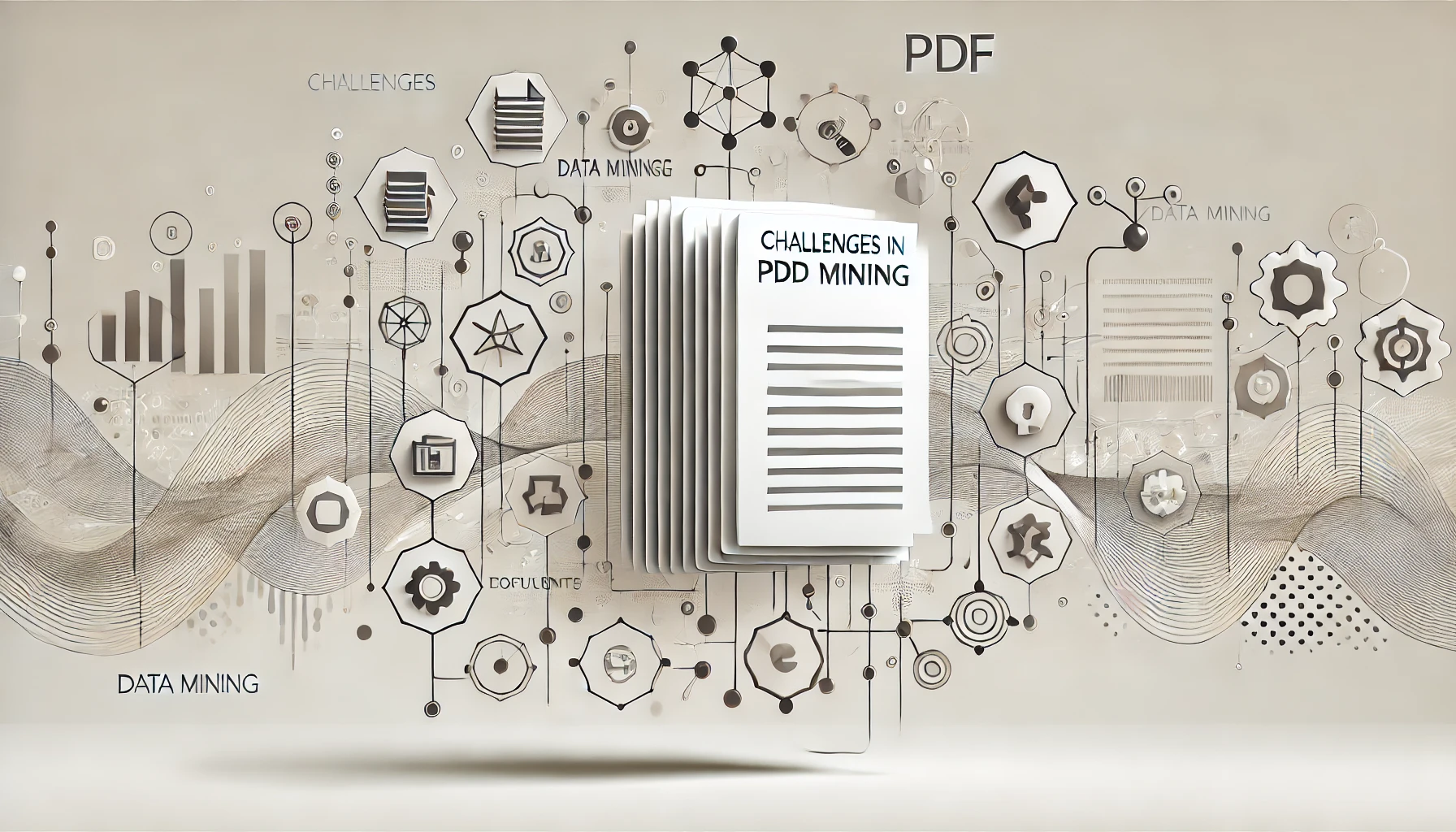As you navigate the world of PDF data mining, you might find yourself encountering a myriad of challenges and opportunities. Understanding the ten best practices in PDF Data Mining can significantly impact the effectiveness of your data extraction processes. From tool selection to compliance with privacy laws, each practice plays a crucial role in shaping the outcomes of your analysis. Stay tuned to uncover insights on optimizing your PDF data mining endeavors and maximizing the potential of your data assets.
Tool Selection
When embarking on PDF data mining, the crucial step of tool selection determines the efficiency and accuracy of your analysis. Selecting the right tools for data mining tasks is essential for successful outcomes. Data visualization techniques play a key role in understanding complex patterns within the data. Visualization tools help in presenting information in a graphical format, aiding in the interpretation of results. Machine learning algorithms are instrumental in automating the process of extracting valuable insights from PDF documents. These algorithms can identify patterns and trends that may be challenging for manual analysis.
Natural language processing (NLP) is another critical aspect of tool selection for PDF data mining. NLP techniques enable the extraction of meaningful information from unstructured text data. Text extraction techniques are vital for transforming PDF documents into structured datasets that can be analyzed efficiently. By leveraging NLP tools, you can enhance the accuracy and depth of your analysis, uncovering valuable insights hidden within the text. Selecting tools that excel in data visualization, machine learning algorithms, NLP, and text extraction is essential for optimizing your PDF data mining process.
File Format Handling
Efficient handling of file formats is a crucial aspect of conducting PDF data mining successfully. When delving into PDF documents, metadata extraction plays a key role in gathering information about the file, such as author, creation date, and keywords. Implementing Optical Character Recognition (OCR) is essential for converting scanned PDFs into searchable and editable text, facilitating text parsing for data extraction. Text parsing involves breaking down the content into structured data for analysis, enabling keyword indexing for efficient searching and retrieval. By carefully managing file formats, you ensure that the data within PDFs is accurately extracted and processed for meaningful insights. Integrating OCR implementation with metadata extraction and text parsing enhances the accuracy and efficiency of PDF data mining. Remember, a well-organized approach to file format handling is fundamental in optimizing the PDF data mining process and unlocking valuable information from your documents.
Data Preprocessing
Data Preprocessing is a critical stage in the PDF data mining process, involving the cleaning and transformation of raw data to prepare it for analysis. To ensure the accuracy and efficiency of your data mining efforts, it is essential to employ data normalization techniques to standardize the data’s scale and range. Text extraction methods are crucial for extracting relevant information from PDF files, converting unstructured text into a structured format suitable for analysis.
Feature selection approaches play a vital role in data preprocessing by identifying and selecting the most relevant features for analysis, reducing the dimensionality of the data and improving the model’s performance. Additionally, data sampling techniques are used to create representative subsets of the data, balancing the dataset and reducing computational complexity.
Large Dataset Management
When managing large datasets in PDF data mining, you must consider efficient data storage strategies to optimize performance. Implementing effective storage solutions such as distributed file systems or cloud storage can help accommodate vast amounts of data. Additionally, utilizing efficient retrieval methods like indexing and caching can enhance the speed at which you access and analyze the information within these datasets.
Data Storage Strategies
One key aspect to consider in large dataset management is the implementation of effective data storage strategies. When dealing with vast amounts of data in PDF data mining, utilizing cloud storage can be advantageous. Cloud storage offers scalability, accessibility, and cost-effectiveness, allowing you to store and manage large datasets efficiently. By leveraging cloud storage solutions, you can offload the burden of maintaining physical servers and benefit from the flexibility to scale your storage capacity as needed.
In addition to cloud storage, database optimization plays a crucial role in enhancing data storage strategies. Optimizing your databases involves fine-tuning performance, improving query efficiency, and organizing data in a structured manner. Implementing indexing, proper data normalization, and regular maintenance routines are key aspects of database optimization that can significantly impact the storage and retrieval speed of your data.
Efficient Retrieval Methods
Considering the vast amounts of data stored and managed through efficient data storage strategies, the focus now shifts towards optimizing retrieval methods for large datasets in PDF data mining. To enhance efficiency, employing advanced data extraction techniques is crucial. These techniques involve identifying and extracting relevant information from PDF documents swiftly and accurately. Additionally, integrating data visualization methods can aid in presenting the extracted data in a more understandable and insightful manner, facilitating quick analysis and decision-making.
Natural language processing (NLP) plays a significant role in efficient retrieval methods by enabling the extraction of valuable insights from text data. Text analysis techniques, a subset of NLP, help in identifying patterns, trends, and relationships within the text, making it easier to retrieve specific information from the vast pool of data. By leveraging these advanced techniques, you can streamline the retrieval process, significantly improving the speed and accuracy of data mining activities on large datasets stored in PDF format.
Data Quality Assurance
Regularly ensuring the quality of data is a critical component of successful data mining processes. Data validation and data cleansing are pivotal steps in ensuring the accuracy and reliability of the information extracted from PDF documents. To achieve optimal data quality assurance, consider the following:
- Consistent Data Validation: Implement rigorous validation checks to detect any inconsistencies or errors in the data, ensuring its integrity throughout the mining process.
- Comprehensive Data Cleansing: Utilize advanced tools and techniques to cleanse the data of any duplicate, inaccurate, or incomplete information, enhancing its overall quality and reliability.
- Regular Auditing Procedures: Conduct frequent audits to review the data quality standards and identify areas for improvement, ensuring that the data remains consistent and up to date.
- Continuous Monitoring: Establish a monitoring system to track the quality of data over time, enabling proactive measures to address any issues that may arise and maintain high data quality standards.
Secure Data Handling
When it comes to secure data handling in PDF data mining, encryption plays a critical role in protecting sensitive information from unauthorized access. Implementing access control measures ensures that only authorized individuals can view or manipulate the data. Data anonymization techniques further enhance security by removing personally identifiable information, safeguarding privacy and compliance with data protection regulations.
Encryption for Protection
To enhance the security of your PDF data during data mining processes, one crucial aspect to consider is encryption. Encryption plays a vital role in protecting sensitive information from unauthorized access. By implementing robust encryption techniques, you can safeguard your data from potential threats and breaches. Here are some key considerations for encryption:
- Key management: Properly managing encryption keys is essential to ensure the security and integrity of your encrypted data. Securely storing and rotating keys are critical steps in maintaining a strong encryption strategy.
- Data masking: Utilizing data masking techniques can help protect sensitive information by replacing real data with fictional but realistic data. This approach ensures that confidential data remains secure during data mining operations.
- Strong encryption algorithms: Employing industry-standard encryption algorithms, such as AES (Advanced Encryption Standard), provides a high level of security for your PDF data.
- End-to-end encryption: Implementing end-to-end encryption ensures that data remains encrypted throughout its entire lifecycle, from extraction to analysis, offering comprehensive protection against unauthorized access.
Access Control Measures
Enhancing the security of your PDF data extends beyond encryption measures; it necessitates robust access control measures for secure data handling. User authentication plays a crucial role in ensuring that only authorized individuals can access sensitive information within PDF documents. By implementing strong user authentication protocols such as multi-factor authentication or biometric verification, you can significantly reduce the risk of unauthorized access.
Furthermore, data encryption should also be coupled with access control measures to provide an extra layer of protection. Encrypting data within the PDF document itself ensures that even if unauthorized access is gained, the information remains unreadable without the decryption key. This dual approach of encryption and access control creates a formidable barrier against potential data breaches.
Data Anonymization Techniques
Utilizing data anonymization techniques is a vital aspect of secure data handling in PDF mining processes. When it comes to safeguarding sensitive information, employing robust data masking techniques and pseudonymization methods is crucial. Here are four key considerations to enhance your data anonymization practices:
- Data Masking Techniques: Implement advanced data masking tools to replace sensitive information with realistic but fictional data, ensuring confidentiality without compromising the overall integrity of the dataset.
- Pseudonymization Methods: Utilize pseudonymization software to replace identifying fields with pseudonyms, making it challenging to attribute the data to specific individuals while still allowing for analysis and processing.
- Anonymization Accuracy: Strive for high accuracy in anonymizing data to prevent reidentification, maintaining the anonymity and privacy of individuals within the dataset.
- Regular Auditing: Conduct regular audits to assess the effectiveness of your anonymization techniques and identify any potential vulnerabilities or areas for improvement in data protection protocols.
Compliance With Privacy Laws
Ensuring compliance with privacy laws is a critical aspect of PDF data mining. Addressing the privacy impact of data mining activities is essential to protect individuals’ sensitive information. Legal compliance is crucial to avoid potential legal repercussions and maintain trust with stakeholders. When conducting PDF data mining, it is important to adhere to regulations such as the General Data Protection Regulation (GDPR) and the Health Insurance Portability and Accountability Act (HIPAA), depending on the nature of the data being processed.
To achieve compliance with privacy laws, it is necessary to implement robust data anonymization techniques. By anonymizing personally identifiable information (PII) within PDF documents, you can minimize the risk of unauthorized access or data breaches. Furthermore, establishing clear policies and procedures regarding data handling and ensuring that all team members are trained on privacy best practices are essential steps towards legal compliance. Regular audits and assessments can help identify any gaps in privacy measures and ensure ongoing adherence to privacy laws.
Efficient Data Storage
When managing PDF data mining projects, efficient data storage plays a crucial role in optimizing performance and accessibility. Utilizing a scalable architecture and integrating with the cloud can enhance your storage capabilities significantly. Here are some key considerations to ensure efficient data storage:
- Scalable Architecture: Implement a storage system that can easily scale up or down based on your data mining needs. This flexibility ensures you can adapt to changing requirements without compromising performance.
- Cloud Integration: Leveraging cloud storage solutions can provide cost-effective and secure storage options. Cloud integration allows for seamless access to data from anywhere, enhancing collaboration and accessibility.
- Data Compression Techniques: Employ data compression methods to reduce storage space while maintaining data integrity. This not only optimizes storage efficiency but also speeds up data retrieval processes.
- Data Backup and Recovery: Implement robust backup and recovery procedures to safeguard against data loss. Regular backups ensure data resilience and minimize the risk of critical information becoming inaccessible.
Machine Learning Integration
To effectively enhance the capabilities of your PDF data mining projects, it is essential to integrate machine learning into your processes. Machine learning algorithms allow for the automation of data analysis, enabling you to extract valuable insights and patterns from your PDF documents efficiently. When integrating machine learning, it is crucial to focus on model evaluation to ensure the accuracy and effectiveness of your predictive models. Model evaluation techniques such as cross-validation and confusion matrix analysis can help you assess the performance of your machine learning models and make necessary improvements.
Additionally, feature selection plays a significant role in machine learning integration for PDF data mining. By selecting the most relevant features from your PDF documents, you can improve the efficiency of your models and enhance the quality of your results. Techniques like recursive feature elimination and feature importance analysis can assist you in identifying the most informative features for your machine learning algorithms. Incorporating model evaluation and feature selection practices will optimize the performance of your machine learning integration in PDF data mining.
Monitoring and Optimization
To ensure the efficiency of your PDF data mining process, it is crucial to utilize data tracking tools that provide real-time insights into the performance of your algorithms. By employing performance analysis methods, you can identify bottlenecks and areas for improvement within your data mining workflow. Implementing continuous improvement strategies based on the insights gained from monitoring and optimization efforts will help enhance the overall effectiveness of your PDF data mining operations.
Data Tracking Tools
By implementing advanced data tracking tools, organizations can effectively monitor and optimize their PDF data mining processes. These tools offer insights into user behavior and enhance the efficiency of data mining algorithms through natural language processing techniques. Here are four essential aspects to consider when utilizing data tracking tools:
- Real-time Monitoring: Gain immediate visibility into how users interact with PDF documents, enabling prompt adjustments to optimize the mining process.
- Behavior Pattern Analysis: Identify recurring patterns in user behavior to tailor data mining algorithms and improve extraction accuracy.
- Performance Metrics: Track key performance indicators like extraction speed and accuracy to enhance overall data mining efficiency.
- Alert Systems: Implement alerts for deviations in user behavior or data mining output, ensuring timely intervention to maintain optimal performance.
Performance Analysis Methods
Regularly assessing the performance of PDF data mining processes is crucial for optimizing efficiency and accuracy. Scalability testing is essential to determine how the system handles increasing amounts of data. By conducting scalability tests, you can identify potential bottlenecks and make necessary adjustments to ensure smooth operations even with larger datasets.
Data visualization techniques play a vital role in performance analysis methods. Visual representations of data can help you identify patterns, anomalies, and trends more effectively than raw numbers. Utilizing tools like graphs, charts, and heatmaps can provide valuable insights into the performance of your PDF data mining processes. These visualizations make it easier to spot areas for improvement, such as processing speed, data accuracy, or resource allocation.
Incorporating scalability testing and data visualization techniques into your performance analysis methods will enable you to fine-tune your PDF data mining processes for optimal efficiency and accuracy. By continuously monitoring and optimizing performance, you can ensure that your data mining operations are running smoothly and effectively.
Continuous Improvement Strategies
Implementing effective continuous improvement strategies is essential for optimizing the performance of PDF data mining processes. To ensure your data mining operations are running at their peak potential, consider the following key steps:
- Utilize Data Visualization Techniques: Visualizing data can provide valuable insights and help identify patterns or anomalies that might not be apparent through raw data analysis alone.
- Leverage Data Analysis Automation: Automating repetitive tasks can increase efficiency and accuracy, allowing you to focus on more complex aspects of data interpretation.
- Incorporate Advanced Data Interpretation Methods: Implementing sophisticated data interpretation methods can uncover hidden trends and correlations within your datasets.
- Optimize Data Mining Algorithms: Regularly reviewing and optimizing your data mining algorithms can enhance the accuracy and speed of your data processing, leading to more reliable outcomes.
Frequently Asked Questions
How Can I Effectively Extract Tables From PDF Files?
You can extract tables from PDFs effectively by using specialized software for data extraction and cleaning. Utilize tools that offer advanced table recognition and text recognition capabilities to ensure accurate results in your analysis.
What Are the Best Techniques for Handling Scanned PDF Documents?
When handling scanned PDF documents, ensure high OCR accuracy by using advanced text extraction techniques. Implementing robust OCR tools and refining text extraction processes can optimize the handling of scanned documents for efficient data mining.
Is There a Way to Automate Metadata Extraction From PDFS?
Imagine your PDF data as a treasure chest waiting to be unlocked. By automating keywords extraction, you can improve the accuracy of metadata extraction, turning your documents into valuable assets effortlessly and efficiently.
How Can I Deal With Non-Standard Fonts and Characters in PDF Data?
When dealing with non-standard fonts and characters in PDF data, you can utilize OCR technology for font recognition and character encoding. This enables accurate text extraction, ensuring comprehensive data analysis and extraction efficiency.
What Are the Recommended Strategies for Handling Image-Heavy PDFS?
When dealing with image-heavy PDFs, focus on OCR accuracy and image compression. Prioritize extracting text through OCR to enhance searchability. Optimize image compression to balance quality and file size, ensuring efficient data extraction and analysis.



